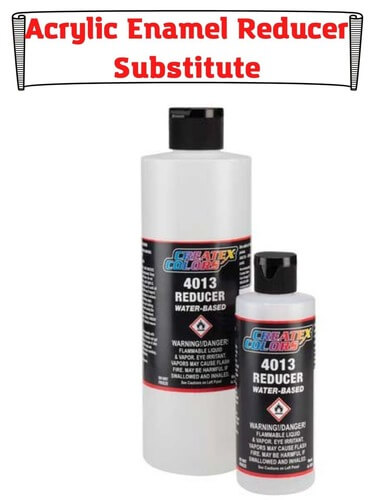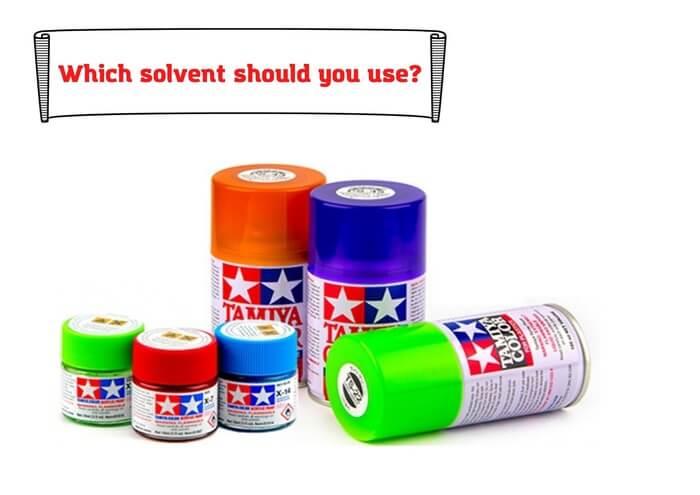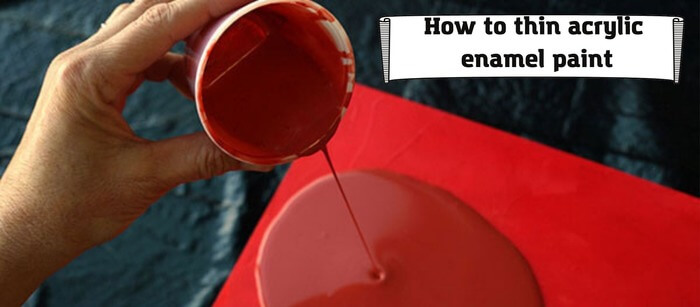
Acrylic enamel reducers are crucial in ensuring that the paint is thin enough for spraying. They help deliver a smoother and more polished finish while preventing the notorious orange-peel texturing and bumps common with fresh paint. In addition, reducers also help offer leveling and adhesion of the acrylic paint.
Reducers are strictly meant for use with acrylic-based paints. In contrast, if you wish to use lacquer-based paints, you must add thinners and not reducers. That is an essential difference to note, and you should always follow the manufacturer’s recommendation regarding the best reducer to acrylic enamel paint combination.
The popular way of thinning enamel paints is with commercial reducers that you can buy from regular hardware stores. These reducers typically contain a unique blend of mineral spirits. Read on to discover other reducer alternatives you can use and still get consistently outstanding paint finishes.
Top reasons to use an acrylic enamel reducer
Thick acrylic paint is usually difficult to apply to produce a nice smooth finish. The paint can even clog your airbrush sprayer, which may cause it to stop working correctly. The solution is to use an enamel reducer to minimize the thickness and consistency of the paint. Here are more reasons to use an acrylic enamel reducer:
- It helps in thinning out the paint before spraying.
- Paint reducers can also be used for cleaning oil paint from your skin and painting supplies, including paintbrushes.
- Reducers can be used to restore paint that may have hardened or thickened after being exposed to air, like through an open lid.
Which solvent should you use when thinning out acrylic enamel paint?

It would help if you took extra care when reducing acrylic paint since thinning it too much may produce undesirable results. Hence, ensure you strictly follow the product datasheets available with the paint and reducer you want to use.
The common acrylic enamel reducer is known as white spirit or mineral spirit. This solvent is ideal for reducing acrylic paints, and it is suitable for a wide variety of applications. The other standard alternative is the commercial enamel reducers which contain mineral spirits.
Acrylic enamel paint reducer substitutes
There are various other paint reducer substitutes available today, and they include the following:
-
Acetone
Acetone is one of the popular substitutes that can be used to thin acrylic enamel paint. However, since acetone is a hazardous solvent that emits dangerous fumes, it is best to wear protective gear like safety gloves and a mask when handling it. Furthermore, ensure you mix the acetone and paint in a well-ventilated place for extra safety.
While acetone can work as an enamel reducer, it is not a great substitute, particularly if you wish to apply the final product on a plastic surface. That is because acetone can affect certain types of plastic surfaces, and it may dissolve, smear, or soften the surface. Hence, if you plan on painting on plastic, it is better to consider other alternatives for the acrylic enamel reducer.
The best and safest application of acetone in painting is for cleaning off oil paint from your painting supplies or other surfaces. Although it can work as a reducer, it can often create issues like uneven finishes, mainly when applied to plastic surfaces.
-
Turpentine
Turpentine is another helpful solvent that can work as an enamel reducer due to its unique properties. For instance, turpentine has a remarkably high evaporation speed, which helps increase the drying time of your paint. It is also easy and comfortable to use compared to other toxic paint solvents.
There are a few considerations to remember when using turpentine as a paint reducer. First, it is best to use turpentine when applying the basecoat layer since you must always start with the fast-drying layers. Also, since turpentine evaporates quickly, you should regularly check your airbrush for any clogging signs.
Overall, turpentine offers various benefits as a reducer, including less offensive smell, less toxicity, and faster drying times.
-
Linseed oil and lemon
A linseed oil and lemon mixture can work well as a reducer for oil-based acrylic paints. You will need at least 1 cup linseed oil and ¼ cup lemon juice for every one gallon of acrylic enamel paint. Mix the linseed oil and lemon in a separate bowl and gradually add the resulting solution to your paint.
After adding at least half of the linseed oil mixture into the paint, give it a few minutes to settle. You can test the paint afterward and see if it has the consistency you want. If you require an even thinner paint, add more linseed oil progressively.
-
Baby oil
The thin consistency of baby oil makes it ideal for use as a reducer. Nevertheless, remember that the addition of extra oil may increase the overall drying time of the surface. Moreover, it will also enhance the glossy level of your acrylic enamel paint.
If you wish to use baby oil as a reducer, then you should ensure that the product you choose does not contain extra ingredients or pigments. For instance, tanning oils will not work as a reducer. Additionally, ensure to mix the paint and baby oil while both materials are at room temperature.
-
Vinegar
Regular vinegar is yet another easy-to-use reducer substitute that you can make at home. The key here is only to add straight vinegar to acrylic enamel paint because other versions may add pigments and destroy the project’s final look. Add at least 177 ml vinegar for every gallon of acrylic paint.
Stir the vinegar and paint mixture thoroughly and let it sit for about five to ten minutes. You can inspect the paint’s consistency after the time has elapsed and then decide whether or not to add more vinegar. Allow the enamel paint to rest and mix well with the vinegar before painting.
-
Rubbing alcohol
Projects that require water-based paints rather than oil-based enamel versions can do with using rubbing alcohol as a thinning solvent. Rubbing alcohol, also known as isopropyl alcohol, is easily accessible from most local drug stores. However, take caution when buying isopropyl alcohol since each product has different amounts of isopropyl, ranging from 30% to 70% or 90%.
Rubbing alcohol products with at least 30% or 70% isopropyl levels work better as acrylic enamel thinning agents. That is because they are not too strong and will not drastically affect the consistency of the enamel paint. However, if you were to use a rubbing alcohol product with 90% isopropyl, it would produce a thicker mixture that would be impractical and unusable.
-
Vegetable oil
Vegetable oil, like sunflower oil, can also work as an acrylic enamel paint reducer. Some of the necessary materials include vegetable oil, a large bucket, a stirring stick, and measuring cups.
Add a gallon of paint to the bucket and add half a cup of vegetable oil. Stir thoroughly until adequately mixed and check if it has reached the desired consistency level. If not, you can add more vegetable oil and mix thoroughly again before painting.
How to thin acrylic enamel paint

Here is the simple step by step process to thin your acrylic enamel paint:
- Read the product label to determine the recommended reducer and the maximum amount required
- Wear safety gear like a respirator and safety goggles to protect yourself while working
- Mix the paint reducer and paint in a 1:4 ratio or as advised by the manufacturer
- Fill your airbrush gun and spray on a test surface
- Continue adding more reducer until you get an even spray
- Make sure to track how much reducer you added onto the paint to simplify future projects
Key considerations when using acrylic enamel reducer substitutes
The various acrylic enamel reducer substitutes shown above should only be used when you don’t have the conventional reducer at hand. That way, you can guarantee more consistent and reliable results with the paint finishes. In addition, you should never add water-based thinners to oil-based acrylic paints since the two compounds will not mix.
The other notable consideration is to avoid any substitute that adds pigmentation to your paint since it will affect the final color. Also, avoid using ingredients with too much alcohol content since it may result in duller colors. The key is to use these substitutions as sparingly as possible.
Finally, it would be best to never use kerosene, vodka, or gasoline to thin oil paints. While these three were widely used in the past as paint reducers, they are highly flammable, which presents severe risks to your health. That said, if you are uncertain about a particular paint reducer, then you should never add it to your acrylic paint. The best way is to wait until you buy the most suitable manufacturer-recommended paint reducer at a store.
Conclusion
The information shown above should assist you in picking the best acrylic enamel reducer substitute for your needs. When using paint reducers, remember to use the appropriate safety equipment, like respirators, goggles, and gloves. Furthermore, avoid working with reducers in low vent or closed areas.
- Shellac Over Mineral Oil – Possible? We’ve Conducted Experiments - January 29, 2022
- Mixing Primer with Texture. And Some Mistakes You Might Make - January 28, 2022
- Acrylic Enamel Reducer Substitute. Safe Testing And Proper Application - January 22, 2022



